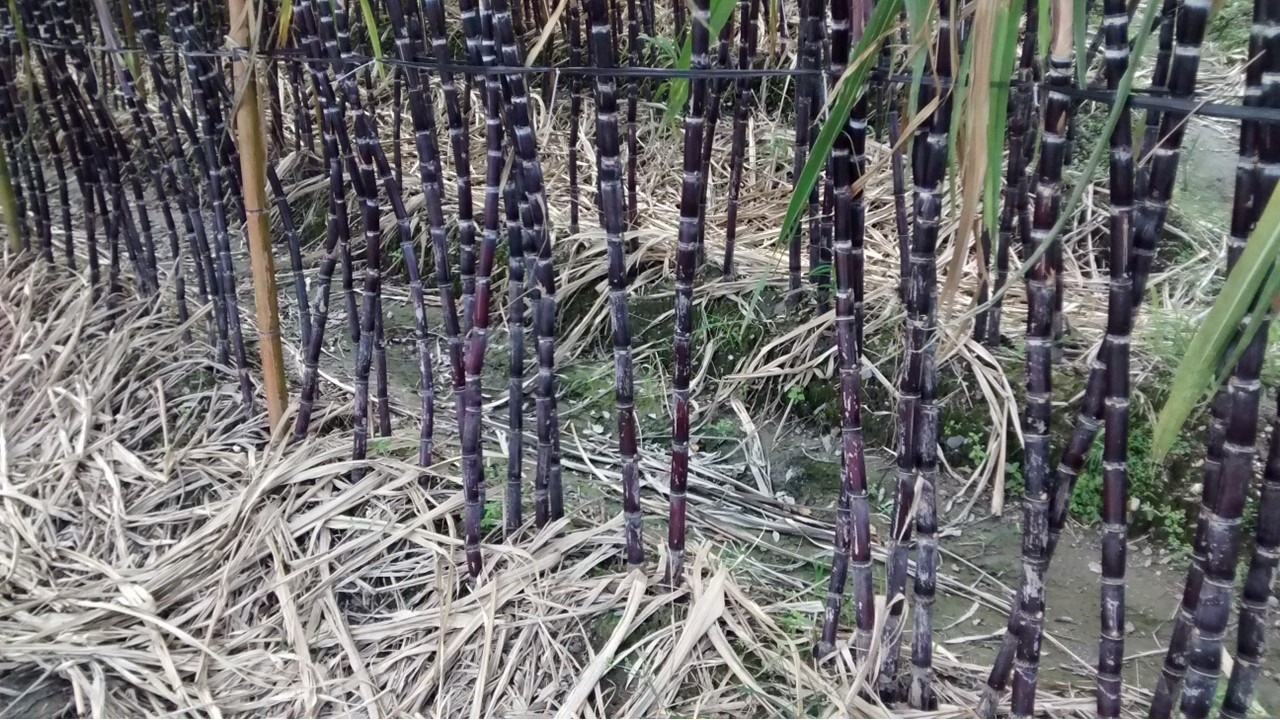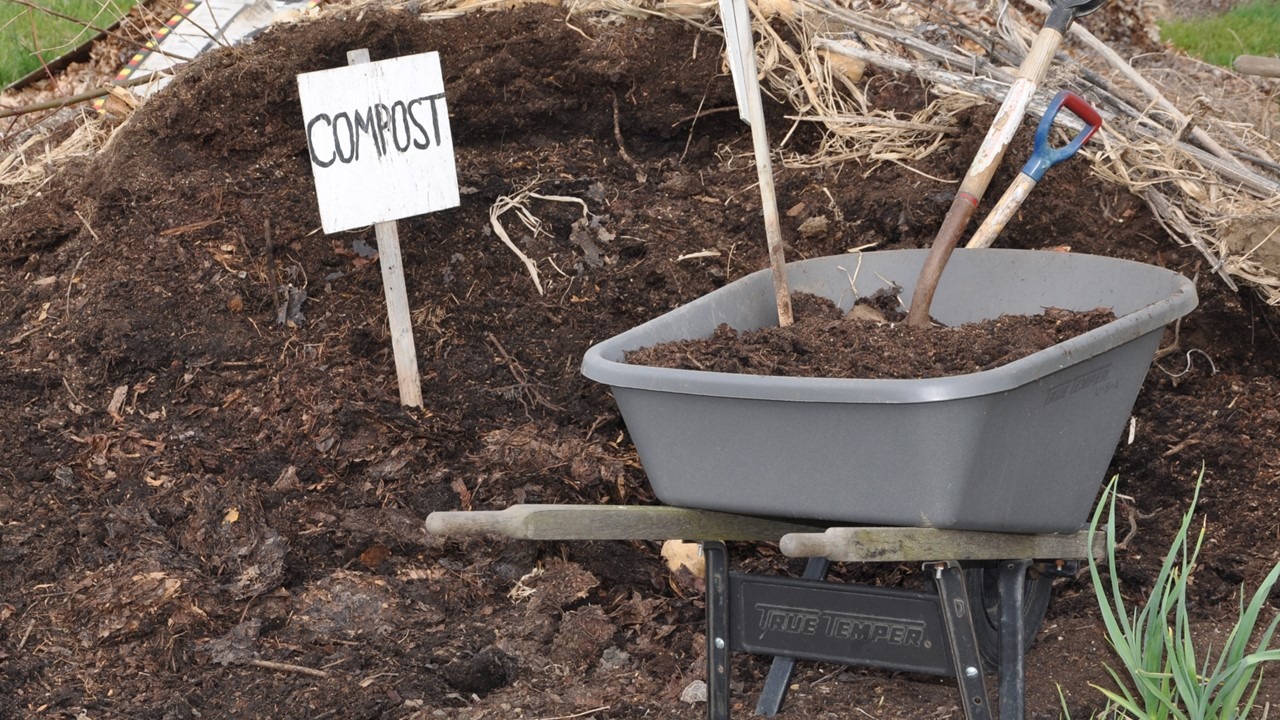When a material is labeled as “biodegradable”, it means it can be decomposed by microorganisms such as bacteria. In recent years, due to the serious problems of energy depletion, environmental pollution, and climate change, people have been looking for new eco-friendly materials to replace plastics and putting a lot of effort into developing biodegradable materials.
This article will introduce the meaning, decomposition process, and characteristics of biodegradation in detail. It will also list currently common applications and explain the impact of biodegradable materials on the environment.
What Does Biodegradable Mean?
Biodegradable is mainly used to describe materials. It means materials can be decomposed by microorganisms such as bacteria, fungi, or algae and then converted into water, gas, and nutrients. As the materials leave no pollution residue at the end of their lifecycle and all substances can be utilized for plant growth, biodegradable is an adjective that represents a good solution to environmental problems.
How Does Biodegradable Work?
With reference to the article “Biodegradation of Biodegradable Polymers in Mesophilic Aerobic Environments”, there are three major decomposition processes of biodegradable materials:
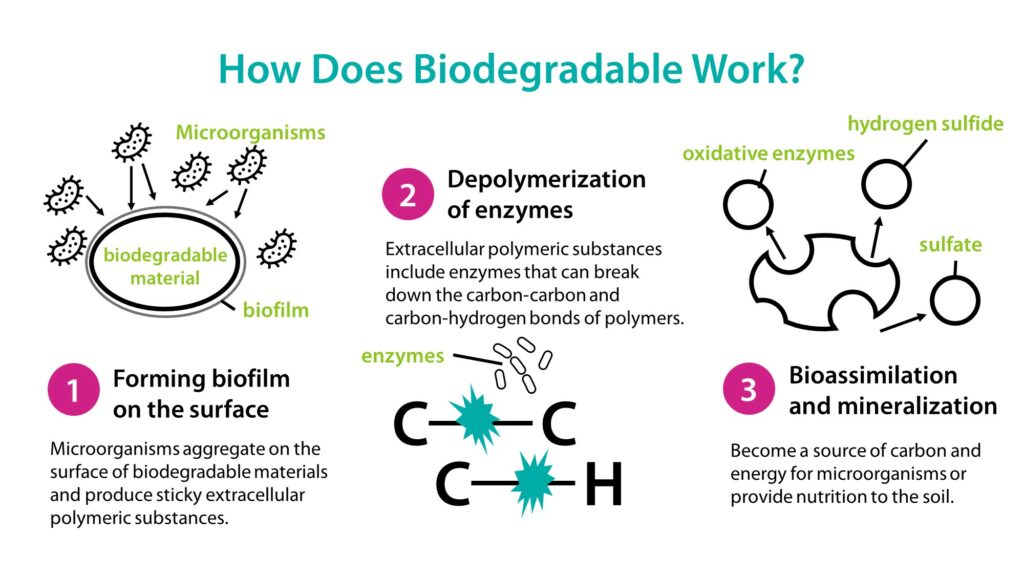
Forming biofilm on the surface
Microorganisms usually have the characteristic of clustering. They attach to the surface of biodegradable materials and continue to produce and attract more microorganisms to form a biofilm and to produce proteins, polysaccharides, nucleic acids, lipids, microbial communities, and so on, which are combined to become sticky extracellular polymeric substances (EPS). Having a biofilm doesn’t mean the biodegradable material is going to decompose rapidly but it could be just a simple cluster of microorganisms. It needs to be observed if there is the next step of decomposition.
Depolymerization of enzymes
After microorganisms have formed a biofilm on the surface of biodegradable materials, the extracellular polymeric substances produced contain enzymes that can decompose organic compounds. The enzymes depolymerize through enzymatic activity by hydrolysis and redox. Biodegradable materials are often organic compounds with a chemical composition of Carbon-Carbon bonds and Carbon-Hydrogen bonds. Carbohydrates, the main components of the bread, cake, and potatoes we often eat, are also composed of these chemical bonds. Enzymatic activity can destroy these bonds and gradually erode and decompose these biodegradable materials. In fact, plastic is also an organic compound and biofilm can be also found on the surface. However, due to the different bond structure, microorganisms can’t destroy the bonds easily (or very slowly), so it takes hundreds of years to decompose it completely.
Bioassimilation and mineralization
Microorganisms may produce oxidative enzymes after depolymerization. These oxidative enzymes can get into the cells of microorganisms for further redox and become a source of carbon and energy for microorganisms. In addition, under conditions of oxygen availability, biodegradable materials can be degraded into mineralized components and biomass, and then compounds such as hydrogen sulfide and sulfate will be released from the biodegradable materials to provide nutrition to the soil.
What are The Features of Biodegradable?
The following are five major factors that affect the speed of biodegradation and the degradation rate:
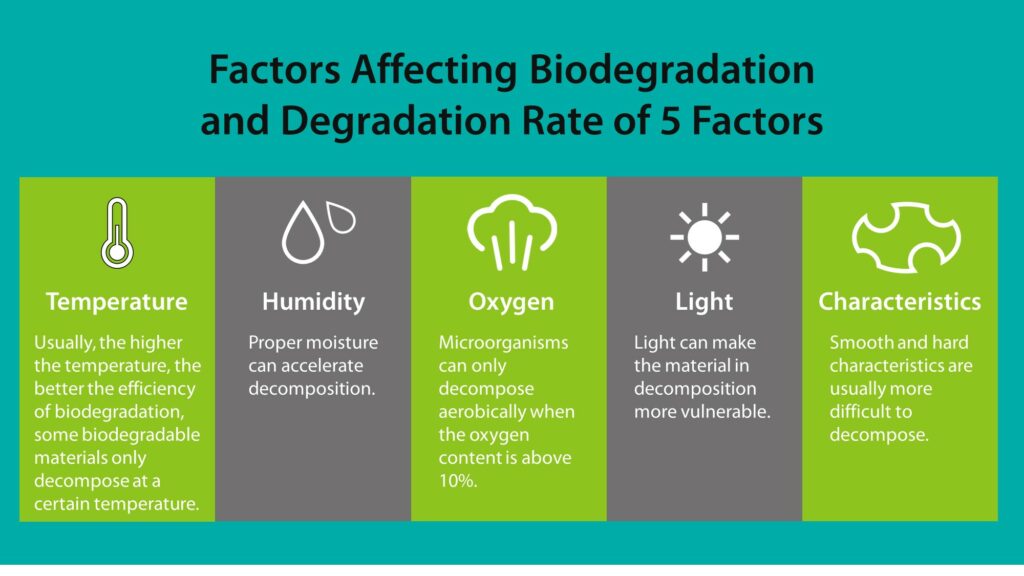
Temperature
Temperature has an influence on the types of microorganisms which can survive and the decomposition activity. Usually, the higher the temperature, the better the efficiency of biodegradation. Heat can be generated by microorganisms during decomposition. For instance, if a compost pile is turned regularly and mixed with the correct proportion of nitrogen-rich and carbon-rich materials, the temperature can rise above 50°C by itself. Please refer to the article “The Benefits of Composting at Home and How to Compost at Home” for how to mix compost and make it heat up by itself for fast decomposition. Some biodegradable materials only decompose at a certain temperature. For example, polylactide (PLA) needs an industrial composting environment (56-60°C) to decompose quickly, as it doesn’t completely decompose much faster than regular plastics at room temperature.
Humidity
Microorganisms need to transport nutrients between cells and grow through water. At the same time, water can also accelerate the decomposition reaction. However, if the humidity is too high, it could result in lack of oxygen contact and lead to anaerobic composting with a slower rate of decomposition.
Oxygen
Generally speaking, air contains 21% oxygen by volume. Microorganisms can survive in a 5% oxygen-deficient environment. However, if the oxygen level is lower than 10%, the process of material decomposition will turn into anaerobic decomposition which generates the greenhouse gas methane and reduces the speed of degradation at the same time. Hence, composting plants usually have a well-designed turning system for composting to ensure sufficient oxygen supply.
Light and ultraviolet
Light and ultraviolet can change both the physical and chemical properties of biodegradable materials, making them more vulnerable. This is beneficial to the subsequent decomposition process of microorganisms.
Characteristics of biodegradable materials
Each biodegradable material has its own composition structure, including fibers of herbs or woody plants, modified organic polymers, and so forth, which will affect the speed of decomposition according to the characteristics of the structure. The harder, more hydrophobic and smooth the surface is, the slower the speed is and the stricter the conditions of the temperature and humidity required are.
The Differences between Biodegradable and Compostable
Both of “biodegradable” and “compostable” are often used to describe eco-friendly materials. The meanings of the two words are similar but there are still some differences. Compostable materials are definitely biodegradable, but biodegradable materials are not always compostable, because the definition of compostable is narrower and stricter than that of biodegradable. Compostable materials are required to completely decompose within a certain period of time under certain conditions, and at the same time they have to be harmless to the environment. Basically, there are two types of composting: home composting and industrial composting. The standard for home composting requires the decomposition of more than 90% within 360 days at room temperature of 20-30°C, while the standard for industrial composting requires the decomposition of more than 90% within 180 days at industrial composting temperature of 56-60°C. Both need safety tests of the decomposed substances to make sure the soil won’t reduce the germination rate of plants after decomposition.
For a detailed introduction and difference between home composting and industrial composting, please read this article: Differences between Industrial Composting and Home Composting: How it works, and labels to recognize.
On the other hand, there are no specific regulations for biodegradable materials in terms of conditions and time. Paper, bagasse and bamboo are common biodegradable materials.
What are Biodegradable Materials? 5 Example Items
Widely used biodegradable materials include polyhydroxyalkanoates (PHAs) produced by microorganisms, polylactide (PLA) synthesized from corn starch, lignin polymer from plants and some special petrochemicals such as polyglycolide (PGA) for surgical sutures, polybutylene succinate (PBS) for making mulching film and polycaprolactone (PCL) serving as medical media. All of the above can be made into various products to replace plastics. However, due to the characteristic of easy-to decompose, biodegradable materials are usually made into disposable products. The following are five common biodegradable products:
Biodegradable straws
There is little chance to recycle and reuse plastic straws given their small size and light weight, and they enter the environment easily. What’s worse, people drink either water or juice every day which results in a considerable number of used straws. According to the statistics from the Ocean Conservancy, the number of straws and stirring sticks picked up in 2016 was the sixth highest among all wastes. Biodegradable straws can reduce the damage caused by straws entering the environment accidentally and avoid nightmares for marine creatures like sea turtles.
Biodegradable lunch boxes
At present, the plastic used to make lunch boxes is mostly polypropylene (PP), which, in theory, is oil-resistant, heat-resistant, and has no plasticizers. However, as the plastic itself is lipophilic, it is likely to be released into food through diffusion when encountering grease, which is harmful to our health. The alternative paper containers are usually coated with chemical coatings to become hydrophobic and oil-resistant on the surface, which may dissolve into harmful chemicals when encountering high temperatures, acids, and alkalis. Using bio-based biodegradable materials can ensure safety and protect us from taking in toxic substances.
Biodegradable bags
Plastic bags are provided in many shops, and some thinner plastic bags are usually used once and discarded. The light and thin characteristics of plastic bags make it easier for the bags to be discarded anywhere and travel to every corner of the world through wind or water. Light weight and thinness are the best choice for the design of biodegradable products—the thinner the material, the faster it decomposes. Therefore, in addition to encouraging consumers to use reusable eco-friendly bags, many shops also provide biodegradable bags as an alternative for consumers to be more eco-friendly when they need bags.
Biodegradable fishing nets
Fishing nets are in direct contact with seawater when used, and microplastics will be released after wear and tear as well as seawater erosion. According to the statistics from the Food and Agriculture Organization of the United Nations, abandoned fishing gear in the ocean accounts for 10% of all marine litter. Because it is difficult for plastics to decompose, the fishing nets continue to capture marine creatures (ghost fishing), which results in ecological catastrophe. Biodegradable fishing nets are designed to decompose naturally in seawater, so that the impact of losing fishing nets on the ecosystem can be reduced.

Seals harmed by ghost fishing, Image: Flicker
Biodegradable mulching film
In modern agriculture, mulching film is used to cover farmland. This can elevate the surface temperature, retain soil moisture, suppress weeds, and promote seed germination. It is difficult to recycle mulching film. Each use will cause a certain number of plastic particles to accumulate in the environment. With biodegradable mulching film, mulching film can continue to support crop growth without causing the problem of plastic leaking into the environment.

Plastic agricultural film, Image: Flicker
Is Biodegradable Really Better for The Environment?
Biodegradable materials are mainly used to substitute general plastics. There is no permanent pollution after decomposing and returning to the environment, so it’s friendlier for the environment. Nevertheless, whether general plastics or biodegradable materials, random discarding has a definite impact on the environment. Therefore, only by disposing all materials in the most suitable way can biodegradable materials be made friendly for the environment.
Biodegradable FAQs
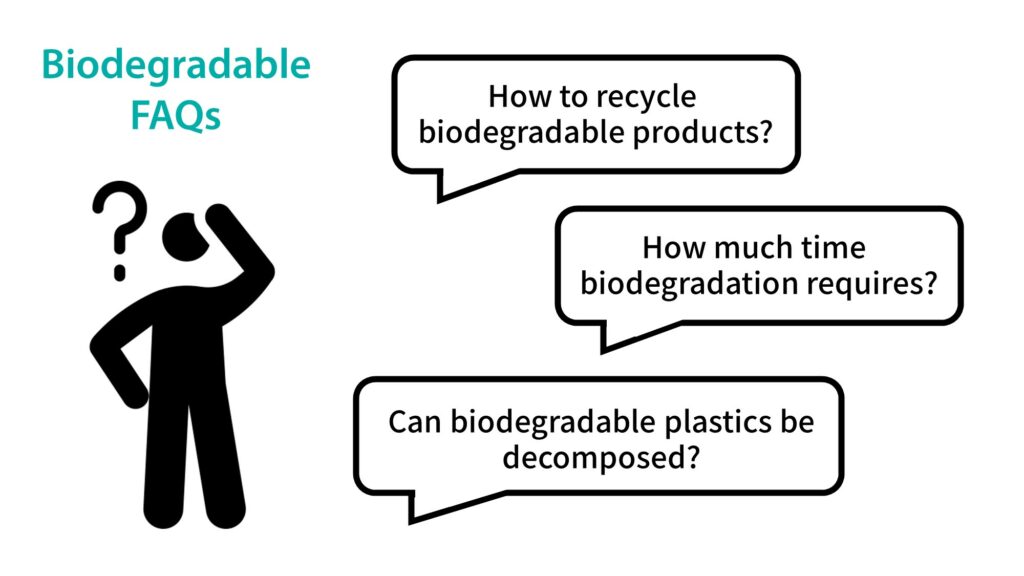
How to recycle biodegradable products
Follow the instructions provided by manufactures to recycle biodegradable products. They either end up in incinerators, composting sites or compost bins. Some manufacturers have additional recycling mechanisms to make up the shortcomings of local governments’ recycling systems.
How much time biodegradation requires
Each biodegradable material has a different decomposition time. Broadly speaking, it’s also called biodegradable even if it takes decades to decompose. However, in current common sense usage, the so-called biodegradable products should decompose within a couple of months in an ordinary soil environment.
Can biodegradable plastics be decomposed?
Biodegradable plastics can be decomposed. They are a new material to replace general plastics and can be decomposed by microorganisms in certain environments.
4 Ways We Can Make a Difference
Choose biodegradable products instead of non-degradable plastics
As mentioned above, biodegradable materials have many applications. We should try to choose biodegradable products instead of non-degradable plastics, especially disposable items such as straws, tableware, bags, and so on, to reduce the impact of products accidentally entering the environment after use. Moreover, bio-based biodegradable materials have the advantages of low carbon and sustainable raw materials.
Reduce the use of disposable products
Some disposable products can be replaced by reusable products without pain. For example, although we may have concerns about hygiene issues caused by the cleaning of stainless steel straws and the safety of carrying them with you, using non-woven shopping bags feels the same as using plastic shopping bags, which is also a good eco-friendly practice to reduce the amount of waste from the source.
Make sure the biodegradable products used have complete certifications and carbon footprints
When we use biodegradable products, don’t forget to check whether they have complete certifications including for composting, safety and health certifications from local regulatory authorities, and so on, to ensure the quality and avoid buying non-eco-friendly products dressed up in sales talk (we call this green washing). Products with carbon labels indicating carbon footprints help us better understand the carbon emissions so that we can choose more eco-friendly products.
What is a carbon label? For more information on carbon labels, read this article: What is a carbon label? Is it important to our environment?
No littering, let the biodegradable design perform the best
To maximize the environmental benefits of biodegradable products, they should be properly recycled. Compostable products should be quickly decomposed in composting facilities and turned into nutrients for the earth. If they are discarded randomly in the environment, they still cause harm before they are completely decomposed.
The Future of The Environment: Is Biodegradable a Long-Term and a Good Way?
The utopia human beings have in mind is one where we can maintain the current quality of life without causing additional impact on the earth. For example, net zero is the most popular topic in recent years. The current core practice is to replace fossil fuels with green energy. Biodegradable materials share a similar concept to replace fossil fuels with renewable plant materials. We hope that the products we use can come from the earth and return to the earth as usable substances for all creatures, just like fallen leaves in autumn are the new nutrients of trees next year.
Biodegradable materials have been used by humans since long ago, but relevant legal regulations and scientific certifications have not been planned until the past 20 years, and they have been accelerated in the last five years. As a new technology, many biodegradable materials are currently facing green washing problems caused by high costs, lack of recycling mechanisms for decomposing in specific environments and market disorder. If we can connect the power of the government, manufactures and each consumer to establish a well-planned recycling system and properly process biodegradable materials, it will be a long-term solution for environmental protection.











